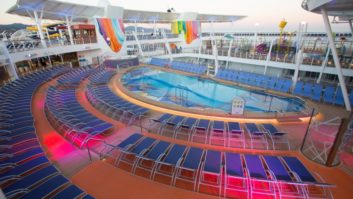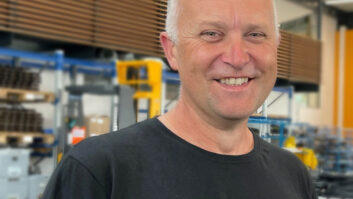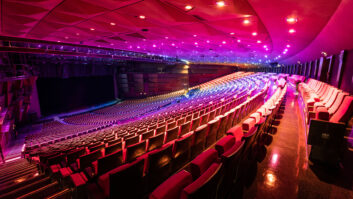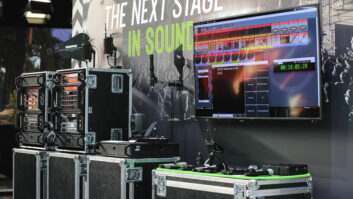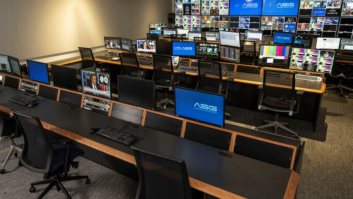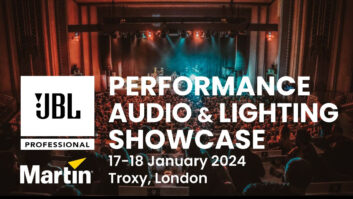Trading without the trade-off. HD projection, intuitive multimedia control, and parallel systems for audio and video conferencing are just some of the standout features of this high-spec installation at a London-based energy-trading centre. Dan Goldstein finds out more.
As anyone who has tried to do any kind of budget for fuel costs over the past 12 months will testify, the global market for energy never stops. One minute the speculators are driving the price of oil and gas through the roof, the next minute those same prices are bumping along the bottom, seemingly in defiance of the world’s recovery prospects.
It is against this tide of volatility that companies such as Constellation Energy try to plot a meaningful course – delivering value to their customers by successfully predicting which way prices are going to go, where, and when. It’s a high-risk business, and a high-tech one, too.
The company’s London offices include a state-of-the-art trading floor equipped with the latest communications hardware, along with a number of breakout rooms or ‘pods’ in which smaller groups of employees can meet confidentially, away from the open, impersonal hubbub of the floor.
In addition, there are three boardrooms with full HD videoconferencing facilities (two of them featuring video projection) and a further three equipped to SD standard. All the rooms are under AMX media control and have been designed to have as many common technological elements as possible, to ensure that employees need only ‘learn’ one room in order to be able to use them all.
MAsolutions, based just outside London, was responsible for designing and implementing the AV infrastructure for the whole facility, as well as maintaining it on an ongoing basis. This required the firm to act not just as systems contractors, but also as interior designers, furniture makers, fabricators and (at times) creative consultants.
“We worked very closely with the architects and the end customer, who had some clear ideas about what they did and did not want to see,” comments MAsolutions managing director Mike Arnold. “For example, there were to be no light switches visible anywhere – so we configured the Dynalite lighting control network, which covers the whole facility, so that the lighting would be activated either via entry sensors or the AMX touchpanels.”
Arnold estimates that it took around five months to go from initial consultations to the finished multimedia product. His company was fortunate to have direct access not just to the architects but also to the IT department at Constellation Energy’s global headquarters in the US, which pre-empted many design issues. Even so, there were the inevitable corporate changes of heart along the way, not least in the facility’s largest boardroom, which, as Arnold explains, “was originally going to have a 60in plasma, but ended up with a 3.5m rear-projection screen”.
Since the proportions of this ‘flagship’ room had already been decided, Arnold and his team redesigned the room’s rack configuration and built their own short-throw rig for the chosen Barco Icon H500 projector. With a dnp projection surface, a Polycom 9004HD videoconferencing system, AMX NetLinx NI3100 control backbone and Kramer VP88HVA RGBHV matrix switcher, the set-up offers multiple picture-in-picture display options. As Arnold says, it is “a large, blank canvas on which you can show many windows, all of which can be resized according to viewing priority”.
Eye for detail
One of the reasons it all works so well is that MAsolutions has been able to exert a telling influence over so many design details. These range from helping to specify the room’s light sources to custom-fabricating the 18-seat boardroom table. The latter includes three recessed AV/LAN/AC mains interconnection modules based on Extron 460xi interfaces, along with 18 beyerdynamic MPC22 or MPC23 conference mics, the difference in polar pattern being dictated by their position on the table.
“Videoconferencing is theatre,” opines Arnold, “and just as in any other theatre, if you take care of the lighting and the sound, everyone has a better experience. We’ve found that the Polycom cameras are very sensitive to the colour temperature of room lighting, so we need to make sure we get that right. For the audio, we did all our own programming of the ClearOne DSPs, and have specified the microphones so that you don’t get the sound of delegates knocking their hands against the surface of the table.”
In fact, the boardroom has entirely self-contained – though still integrated – systems for audio and video conferencing, with the former capable of working separately from the latter. A ‘telephone’-style user interface on the room’s 15in AMX touchpanel (which can be connected to any one of the three table boxes, depending on meeting configuration) allows staff to select between the two kinds of conference, while the room’s JBL Control series loudspeakers can be configured for 5.1-channel ‘conference sound’ or 3-channel ‘show sound’.
Similar set-up
Videoconferencing Room 2, the other space to use projection as its main source of video imaging, has the same audio flexibility and, indeed, is identically configured in many respects. It shares the same AV backbone, the same AMX touchpanel interface, and even the same table design and functionality – though in this instance the top-panel finish is white and the microphone finish is silver, to reflect (no pun intended) the room’s more modern aesthetic. Lack of sufficient room length obliged MAsolutions to adopt a front-pro solution here, but Arnold says that using dnp’s latest high-gain Supernova screen surface (in this case with a 3m diagonal) has given the customer “brightness and contrast levels that are almost identical to rear projection”.
The remaining high-definition videoconferencing room uses a 65in NEC plasma panel rather than projection, yet users still enjoy the same flexibility in terms of table-box connectivity, multimedia control, audio configuration and, of course, HD image quality – something that few corporate customers are happy to do without once they have sampled it.
That said, even the three SD v-con spaces have been well used by the London office since they became operational – this is most definitely not a case of too much technology, too little time. Partly this must be because, like so many corporate entities, Constellation Energy wants to cut travel costs and sees videoconferencing as the ideal way for employees in remote offices to keep in touch with one another without spending a fortune on flights and hotels. But it is also because the systems have been designed to be intuitive and (perhaps more unusually) attractive.
Additionally, MAsolutions has been able to ensure that technical breakdowns are kept to a minimum, again using an elegant implementation of the available technology. “Everything here is IP-addressable, which enables fault detection to be undertaken remotely from our offices,” concludes Arnold.
“But since we are only down the road, we are just as likely to come in here with a wireless PC and run a check on the network from, say, an unused breakout room. We can detect and correct most faults without disturbing a meeting. The customer doesn’t even need to know that we’re there!”
